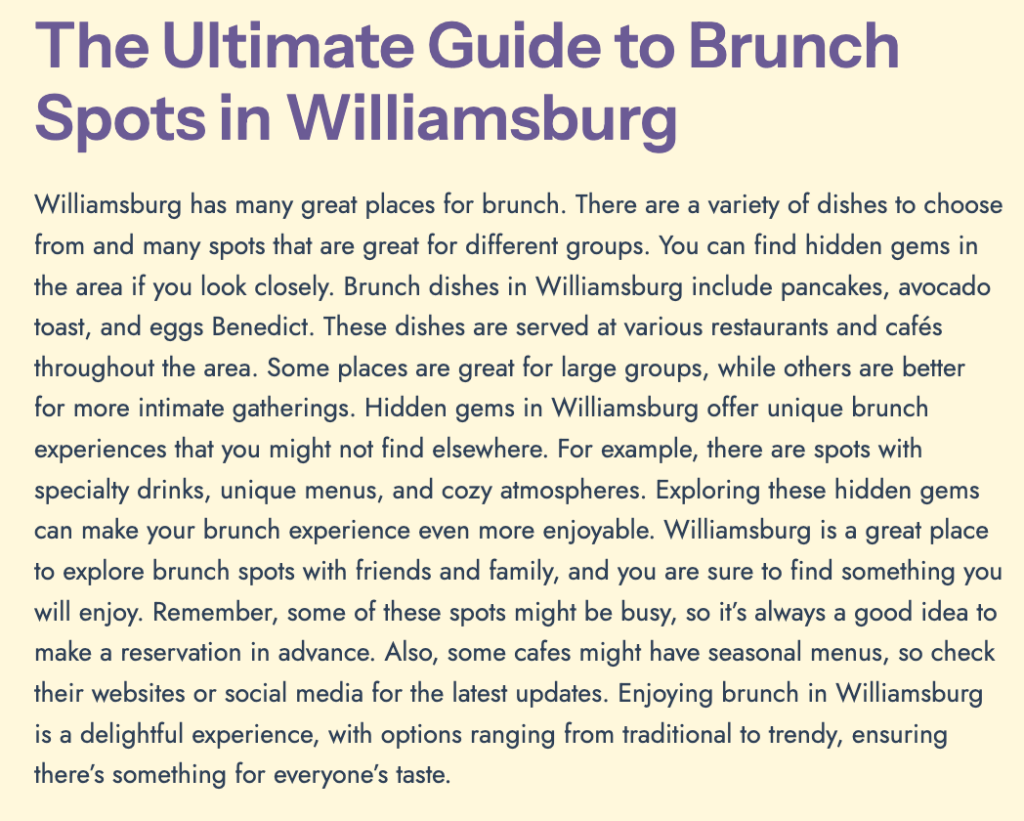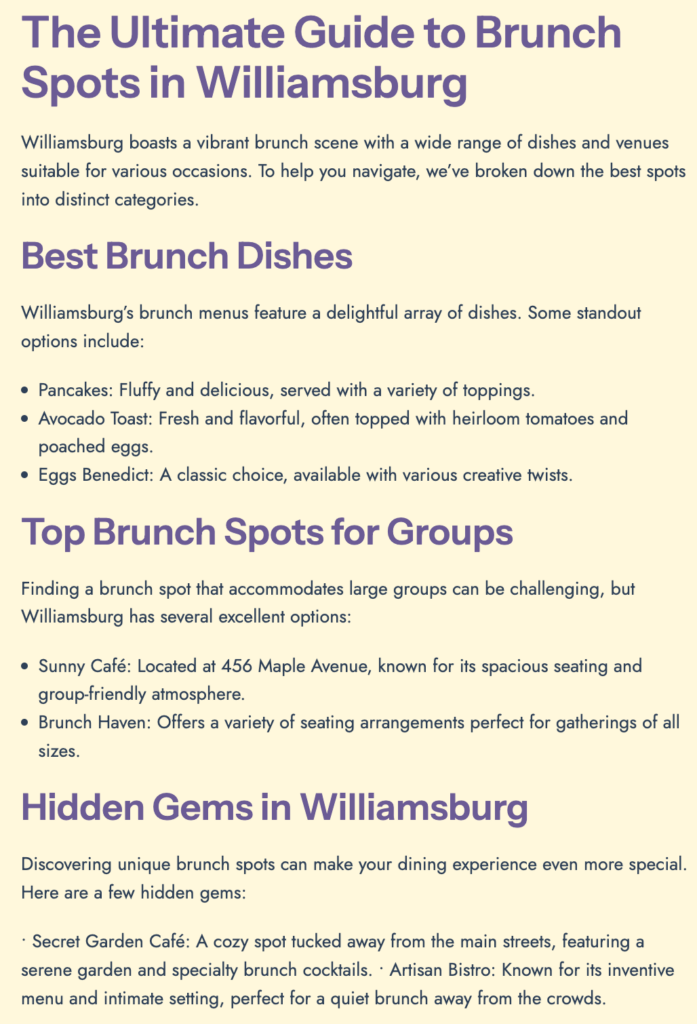Updating your old blog posts is crucial for maintaining relevance, improving SEO, and keeping readers engaged. Outdated content can lead to lost traffic and decreased interest, so it’s essential to refresh and revitalize your posts. In this guide, we’ll use an example blog post titled “The Ultimate Guide to Brunch Spots in Williamsburg” as an example to illustrate each step. Here’s how you can transform your old content into fresh, valuable resources.
1. Update stats, facts and dates
Outdated statistics or references can make your content seem less relevant or accurate. Start by replacing old data with the most recent information to ensure your blog post remains trustworthy and up-to-date. For instance, if your post includes statistics from 2019 about the number of brunch spots in Williamsburg, update this to reflect the current number of establishments in 2024. Change “As of 2019, Williamsburg has over 20 popular brunch spots” to “As of 2024, Williamsburg has more than 30 trendy brunch spots.”
This step not only improves the accuracy of your content but also shows your readers that your blog is a reliable source of current information. Regularly updating facts and figures keeps your content relevant and helps build trust with your audience.
2. Revise and expand content
Adding more details and expanding on existing information can significantly enhance your post. Dive deeper into the topics, provide additional context, and include updated descriptions to offer more value. For example, instead of just mentioning “Sunny Café offers a variety of brunch options” expand this to: “Sunny Café, located at 456 Maple Avenue, is known for its inventive brunch menu featuring dishes like avocado toast with heirloom tomatoes and their famous fluffy buttermilk pancakes. With a charming patio and locally sourced ingredients, it’s a must-visit spot for brunch enthusiasts.”
Providing more detailed and vivid descriptions can make your content more engaging and informative. Expanding on each point helps readers get a clearer and more comprehensive understanding of the subject, which can enhance their overall experience and satisfaction with your blog.
3. Optimize for SEO
Enhancing your post’s SEO helps attract more organic traffic and improves visibility. Update the title, meta descriptions, and headers with relevant keywords to boost your search engine rankings. For instance, change a generic title like “Best Brunch Spots in Williamsburg” to “Top 10 Brunch Spots in Williamsburg You Must Try in 2024.” This incorporates current keywords and reflects the updated nature of your content.
Additionally, ensure that your content is structured in a way that makes it easy for search engines to crawl and index. Use appropriate header tags (H1, H2, H3) to organize your content, and include internal links to related posts to enhance your site’s SEO further.
4. Improve readability
While updating your blog post, make sure that you enhance its readability as well, as it makes your content easier to consume and engage with. Use clear headings, bullet points, and short paragraphs to make your post more visually appealing and accessible. For example, replace a lengthy paragraph such as “Sunny Café offers a variety of brunch options including pancakes, avocado toast, and sandwiches” with a bulleted list:
- Sunny Café
- Location: 456 Maple Avenue
- Highlights: Avocado toast, buttermilk pancakes
- Atmosphere: Cozy with a charming patio
- Specialties: Locally sourced ingredients
This format helps readers quickly grasp key points and improves engagement. Break up large blocks of text with subheadings and lists to make the content more digestible and user-friendly.
5. Add internal links
Including internal links encourages readers to explore more of your content. This keeps visitors engaged and helps with SEO by distributing link equity across your site. Within the section about Sunny Café, add a link to another related post like “Check out our guide to the best coffee shops in Williamsburg.” This provides additional value and helps readers discover more of your content.
Internal linking creates a more connected and navigable site, which can improve user experience and keep readers on your site longer. It also helps search engines understand the structure and hierarchy of your content, potentially boosting your search rankings.
6. Refresh visuals
Outdated or low-quality images can diminish the appeal of your post. Update visuals with high-resolution, relevant images that better represent the content and improve user experience. When you’re updating your blog post, replace an old image of Sunny Café with a recent, high-resolution photo showcasing the café’s updated interior or popular brunch dishes. This enhances the visual appeal and relevance of your post.
Visual content is crucial for capturing and maintaining readers’ attention. High-quality, relevant images can make your post more attractive and engaging, encouraging readers to stay longer and explore further.
7. Update external links
Ensure that all external links in your post are current and lead to relevant, functioning pages. Broken or outdated links can frustrate readers and damage your site’s credibility. If your post originally linked to a review of Sunny Café from a local food blog that no longer exists, replace it with a link to a recent review or news article about the café.
Regularly checking and updating external links is essential for maintaining the quality and reliability of your content. Functional and relevant links contribute to a positive user experience and can help build trust with your audience.
8. Revise formatting and structure
Review the formatting and structure of your post to ensure it’s well-organized and easy to navigate. Use headers, subheaders, and appropriate formatting to enhance readability. If your original post lacked clear section headings, add them to break down the content into distinct parts, such as “Best Brunch Dishes” “Top Brunch Spots for Groups” and “Hidden Gems in Williamsburg” This helps readers quickly find the information they’re interested in.
A well-structured post with clear headings and subheadings makes it easier for readers to navigate and find the information they need. It also helps search engines better understand the content and context of your post.


9. Incorporate reader feedback
Consider incorporating feedback from your readers to address their questions and concerns. This adds value and shows that you listen to your audience. If readers frequently ask about vegetarian options at the brunch spots, include a new section in your updated post titled “Vegetarian-Friendly Brunch Spots in Williamsburg” and highlight any relevant menu items.
Listening to your audience and responding to their feedback can help you create more relevant and valuable content. It shows that you value their input and are committed to meeting their needs and preferences.
10. Promote your updated post
Once you’ve refreshed your blog post, promote it to reach a wider audience. Share it on social media, include it in your newsletter, and update any related posts or pages with a link to the refreshed content. After updating “The Ultimate Guide to Brunch Spots in Williamsburg” create social media posts and an email newsletter announcement highlighting the new content and inviting your audience to check out the updated guide.
Promoting your updated content helps you reach new readers and re-engage your existing audience. Regularly promoting refreshed posts can help you maintain visibility and attract more traffic to your blog.
Keep your blog fresh and engaging
Regularly updating your blog posts is essential for keeping your content relevant, engaging, and valuable to your readers. By following these ten practical steps, you can transform old posts into fresh resources that continue to attract and engage your audience. With a focus on current information, enhanced readability, and strategic promotion, your blog will remain a trusted source of valuable content. Keep your posts updated and your audience engaged to maintain the impact of your blog over time.
For a more strategic, long-term approach to keeping your entire blog fresh and relevant, check out our post on how to maintain your blog posts. While the steps in this guide help you refresh individual posts, maintaining your blog requires ongoing care and consistency. Learn how to create a maintenance routine that ensures all your content stays up-to-date, aligned with your branding, and valuable to your readers over time.
